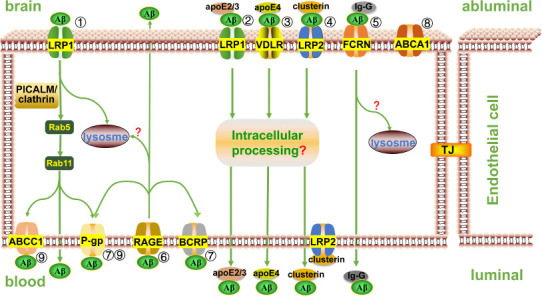Figure 2.

Receptors and transporters mediate Aβ transport across the blood-brain barrier.
① By binding to PICALM, the Aβ-LRP1 complex is integrated into a clathrin-coated pit and then cleared from the brain via transcytosis or directed to lysosome for degradation. ② Aβ-apoE2 or Aβ-apoE3 complex binds to LRP1 and forms endophagocytic vesicles, which are then discharged at the plasma membrane on the other side of the endothelial cell via transcytosis. ③ Aβ-apoE4 complex interacts with very low density lipoprotein receptor (VLDLR) and is slowly endocytosed, then cleared from the endothelial cells by transcytosis. ④ Aβ-clusterin complex can bind to LRP2 receptor on both sides of the endothelial cell membrane for bidirectional transport, but LRP2 is usually occupied by clusterin rather than Aβ-clusterin complex on the luminal side, so the net flow is Aβ outflow. ⑤ FcRn mediates IgG-Aβ transport from the brain into blood via transcytosis. ⑥ Luminally expressed RAGE binds to circulating Aβ and transcytoses it from blood to the brain. Both FcRn- and RAGE-mediated Aβ clearance may be involved in the endosomal/lysosomal pathway. ⑦ P-gp may assist LRP1-mediated Aβ transport and pump Aβ directly into the blood from the lumenal side of endothelial cells. P-gp and BCRP also assist in the excretion of circulating Aβ transported by RAGE into endothelial cells. ⑧ ABCA1 does not directly mediate Aβ trafficking across the BBB; it promotes proteolytic degradation of Aβ in the brain parenchyma and affects the clearance of Aβ across the BBB by regulating lipogenation of apoE. ⑨ LRP1 first mediates Aβ endocytosis, and then Aβ is transported from the abluminal side to the luminal side of the endothelial cells. Subsequently, P-gp and ABCC1 export Aβ from the luminal membrane of endothelial cells to the systemic circulation. ApoE: apolipoprotein E; Aβ: amyloid-beta; BCRP(ABCG2): breast cancer resistance protein; LRP: low density lipoprotein receptor(LDLR)-related protein; P-gp: P-glycoprotein; PICALM: phosphatidylinositol binding clathrin assembly protein; RAGE: advanced glycation end products; VLDLR: very low density lipoprotein receptor.
